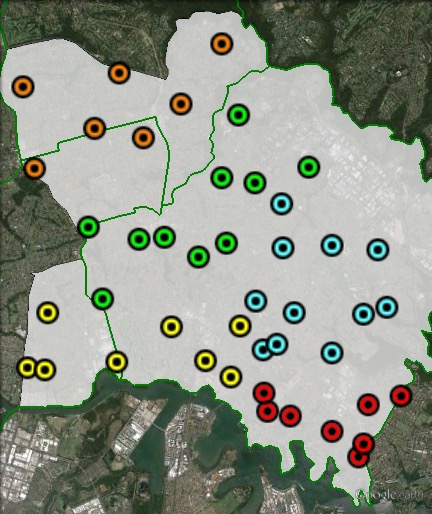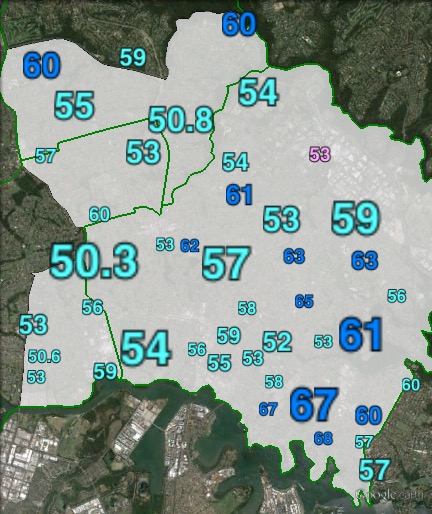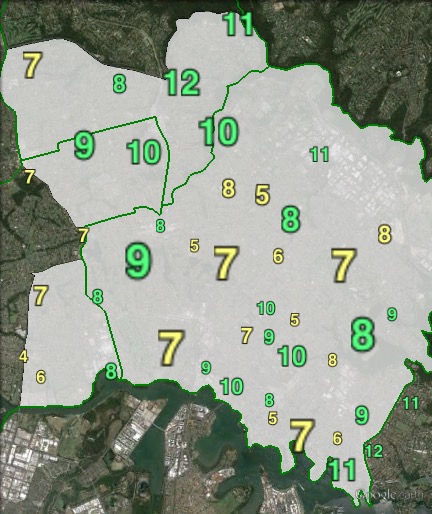LIB 7.8%
Incumbent MP
John Alexander, since 2010.
Geography
Bennelong straddles the north shore and western suburbs of Sydney. The seat covers the entirety of Ryde local government area, as well as Epping, Carlingford and Ermington, from Hornsby and Parramatta council areas. Main suburbs in the seat are Ryde, Epping, Ermington, Eastwood and Gladesville.
Redistribution
No change.
History
Bennelong was created in 1949, and was held by only two MPs between then and the 2007 federal election. Bennelong originally covered Ryde, Hunters Hill and Lane Cove, but not areas such as Eastwood and Epping that are now contained within the seat.
Bennelong was first won by John Cramer (LIB) in 1949. Cramer served as Minister for the Army under Robert Menzies from 1956 to 1963. During his time holding Bennelong the seat was never a very safe seat, and in 1961 Cramer only held on by 1832 votes. His largest margin was 15.4% in 1966.
Cramer retired at the 1974 election and was succeeded by John Howard (LIB). Howard went on to serve as a minister under Malcolm Fraser, including as Treasurer from 1977 to 1983. He then served in a variety of roles on the opposition frontbench after 1983, including as two stints as Opposition Leader (1985-1989, 1995-1996). He was elected as Prime Minister in 1996 and served until 2007.
The seat of Bennelong had gradually shifted to the north-west over the decades, taking in Epping. The 1992 redistribution saw the last parts of Lane Cove removed from the seat, and Howard’s margin was cut in 1993. After recovering in 1996 to a margin over 10% it gradually declined to a 4.3% margin in 2004, when the Greens ran high-profile former intelligence officer Andrew Wilkie against Howard.
The 2006 redistribution saw Howard’s margin cut slightly and the ALP decided to target the seat, running former journalist Maxine McKew. McKew won the seat with 51.4% of the two-party vote.
In 2010, McKew was defeated by former tennis champion John Alexander. Alexander won a second term in 2013.
Candidates
- Lyndal Howison (Labor)
- John August (Pirate)
- Justin Alick (Greens)
- Julie Worsley (Christian Democratic Party)
- Christopher Gordon (Arts Party)
- John Alexander (Liberal)
- Martin Mulcare (Independent)
Assessment
While Labor did win this seat in 2007, that was the result of a longstanding campaign. Alexander will probably win re-election in 2013, unless Labor’s campaign is extremely successful.
2013 result
| Candidate | Party | Votes | % | Swing |
| John Alexander | Liberal | 46,907 | 53.0 | +4.5 |
| Jason Yat-Sen Li | Labor | 28,726 | 32.5 | -4.7 |
| Lindsay Peters | Greens | 7,454 | 8.4 | +0.5 |
| Julie Worsley | Christian Democratic Party | 2,135 | 2.4 | +0.3 |
| Robert James Marks | Palmer United Party | 1,589 | 1.8 | +1.8 |
| Lachlan Patrick Mccaffrey | Democratic Labour Party | 617 | 0.7 | +0.7 |
| John August | Secular Party | 602 | 0.7 | +0.7 |
| Victor Waterson | Australia First | 492 | 0.6 | +0.6 |
| Informal | 7,200 | 8.1 |
2013 two-party-preferred result
| Candidate | Party | Votes | % | Swing |
| John Alexander | Liberal | 51,139 | 57.8 | +4.7 |
| Jason Yat-Sen Li | Labor | 37,383 | 42.2 | -4.7 |

Booth breakdown
Booths have been divided into five parts around the main suburbs of Bennelong: Eastwood, Epping, Gladesville, Ryde and West Ryde.
The Liberal Party won a majority of the two-party-preferred vote in all five areas, ranging from 55% in Eastwood and West Ryde to 62% in Gladesville.
The Greens came third, with a vote ranging from 7.3% in West Ryde to 9.2% in Epping.
| Voter group | GRN % | LIB 2PP % | Total votes | % of votes |
| Eastwood | 8.0 | 54.9 | 16,198 | 18.3 |
| Ryde | 8.0 | 58.0 | 15,052 | 17.0 |
| Epping | 9.2 | 56.5 | 13,017 | 14.7 |
| West Ryde | 7.3 | 55.1 | 11,306 | 12.8 |
| Gladesville | 8.5 | 62.4 | 8,787 | 9.9 |
| Other votes | 9.1 | 59.8 | 24,162 | 27.3 |




The AEC’s decision not to alter Bennelong profoundly annoyed me. As a voter in North Sydney, iv’e always believed that Hunters Hill LGA has no place in our electorate. It absolutely belongs in Bennelong.
Bennelong would therefore lose it’s NW Epping section, making it mostly a Ryde LGA electorate.
Bennelong has moved slowly west over time. (See the seat profile on the ABC election site.) A shift eastwards was never likely to happen in a redistribution where the state lost a seat.
I can see nothing wrong with retaining Hunters Hill LGA in North Sydney. The state seat of Lane Cove also straddles the mouth of the Lane Cover river. (As once did Bennelong.)
DW
Your points are valid. However Lane Cove is not N Sydney.
Predominantly, my desire is for my electorate, to have the best community of interest , & representation possible.
Consider that i personally have been moved THREE times in 20 years of residence. If i lived in Castle Cove it would be 4 times. Willoughby LGA is split between 2, & sometimes 3 !!!! Fed electorates. This is unnecessary, & quite unacceptable at times.
It is irritating to be the plaything, & convenience of the AEC.
IIRC, Bradfield and Berowra were well under quota so needed topping up from North Sydney. Once that was done, there was no room for Hunters Hill to be removed as well.
Continued growth closer to the city will probably see Bennelong move back into Hunters Hill eventually.
MM
I don’t agree .
Bradfield could have moved north west, & Berowra, & Mitchell reoriented.
There just was no desire to do so. It was so much easier to continue to ignore the Willoughby LGA , Warringah RD , boundary. In Spite of this being an incredibly clear boundary, & landmark.
The big question here is whether or not John August can improve upon his 2013 vote now that he has abandoned the Secular Party to run as a Pirate Party candidate! What’s next, the Humanist Cyclist Party?
WD, Putting Hunters Hill in Bennelong might be good for the Liberal Party, but it would weaken the community of interest in Bennelong. I grew up in Ryde. It is North-West or Northern Districts and definately NOT North Shore. Hunters Hill is a harbourside area and fits with Lane Cove. Certainly it has a much more North Shore feel to it than suburban Ryde! Epping is a much better fit with Bennelong and if it needed to expand Rydalmere, Dundas or even Carlingford would be better geographic and demographic fits
than Hunters Hill. If you think of North Sydney as the Lower North Shore electorate, its the logical home for Hunters Hill.
My prediction: John Howard’s old seat, Liberal hold, unless Labor win in a landslide.
Some very interesting results here going through the booth figures. Overall 2% swing to the Libs, which you’d expect. The western end around Ermington & West Ryde swung 2-3% to ALP, reflecting the fault line between Western and Inner Sydney. Eastern and northern parts swung Liberal.
However there were large swings TO the Liberals in the Eastwood & Epping area, including 13% 2PP in the large Eastwood booth – almost replicating historical results from the 1980’s. Any ideas? Does John Alexander have a strong appeal with the local Chinese community?
@Peterjk could be the loss of the Chinese vote for Labor’s candidate. Last time they nominated a high-profile community leader who was Asian, he likely had significant appeal here. With him gone, perhaps Alexander was able to tap into that voting demographic much more successfully this time?
Also it is interesting to note that in the Hurstville pre-poll booth down in Banks, there was also a considerable swing to the Liberal Party. Perhaps Turnbull’s message and popularity (I hear that the Chinese community greatly admires Turnbull’s business acumen) was far more resonant with the Asian community than Shorten’s Medicare campaign?
@Wreathy that explains it. Thanks!
This would not have helped either:
https://www.buzzfeed.com/lanesainty/unauthorised-flyers-warn-of-death-and-rape-if-labor-victory
The higher income seats have seen more of a a swing away from Labor (or less of a swing towards them). Examples of this are Kooyong, Goldstein, Curtin, Brisbane, and Melbourne Ports. Would have helped someone like Kelly O’Dwyer to hold her seat in Higgins as well.
I actually suspect that the difference lies in attitudes towards Turnbull vs Abbott. Abbott tended to appeal to the lower income people who cared more about social issues and are socially conservative. Turnbull appeals to the businessmen and those who are more socially liberal but right-wing.
So the more conservative seats saw a bigger swing against the Coalition, since they’d lost “their” PM, while the socially liberal right-wing seats saw less of a swing (or more swing towards the Coalition), as they’d gained a PM much more in line with their views.
So the inner-city seats tended to favour Liberals more, while the “outer” seats tended to be hit harder.
It’s also why the Liberals did quite well in seats that see high Greens vote, and poorly in the seats that tend to get more votes from parties like One Nation and Family First.
At least, that’s what I think has happened.
@Glen I tend to think you’re correct, especially in Western Sydney.
Glen that’s the point I was making at first in Bennelong, the western fringes of the electorate swung ALP, reflecting (but more moderately) the Western Sydney swing, while the rest swung towards the Liberals…but then I noticed the massive swings in the Eastwood / Epping area, that were completely out of kilter with the small pro-Liberal swings seen the rest of Bennelong and indeed in many inner-city areas. There has to be another explanation for these and I think these have been provided by Wreathy and David Walsh above.
I’ve often wondered if there is an opportunity for the Liberals to peel of some of the socially conservative ALP ethnic vote. Using the CDP as a front group for this could actually be quite an effective strategy if it were to be done on a concerted basis, using the ethnic media. The Liberals can’t do it themselves of course because they would turn off a lot of other voters, but there would be no repercussions on them having the CDP do it for them, with a little ‘assistance’
Good theory about Liberal voters, but why the ~10% decreases in the Liberal primary vote in Mackellar, Warringah and North Sydney?
Just an update, the Liberal margin is the largest here since 1996. Clearly IMV Labor’s win in 2007 was an aberration achieved more by a longstanding and targeted campaign rather than any true and significant demographic change. Although obviously both worked in Labor’s favour.
@Wreathy I disagree. Something has changed, but I’m not quite sure what. The ALP vote was creeping up, as it also did in Lowe/Reid since 1996 – but the trajectory has altered and it’s veered sharply downwards at the last couple of elections. Reid has followed exactly the same pattern. I suspect there is a link and it might have something to do with improved Liberal support among ethnic Chinese voters due to the last Labor federal (and state?) government.
@Peterjk perhaps. Adding to your Chinese theory, it’s probably the case that the Liberals have been able to improve among ethnic voters generally too, especially those of eastern European, mainly Italian ancestry in Reid.